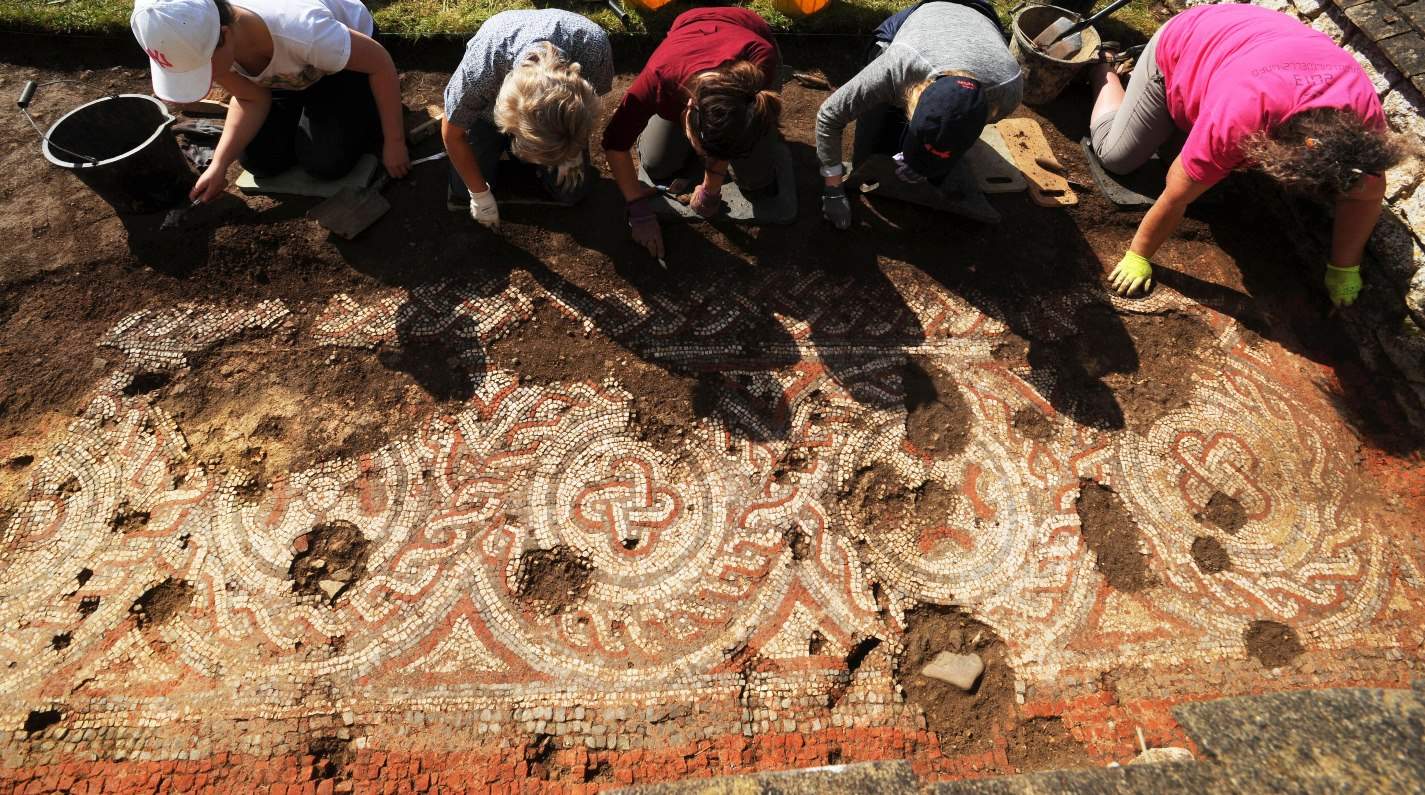England, major discovery: 5th century Roman mosaic could rewrite history
In England, a discovery has been made that may in part rewrite the history of Britain after the end of Roman rule: in a Roman villa in Gloucestershire (to be precise in the Cotswolds area, in the village of Chedworth) a mosaic has been found that has been dated, by the carbon14 method and following technical and stylistic analysis, to the fifth century AD. This is the first Roman mosaic from that period found on English soil, and the discovery is most important because it reveals that Roman culture survived even after the end of Roman rule over Britain (the Empire in fact abandoned Britain in 410, and Roman rule was replaced by that of the Germanic peoples, namely the Angles, Saxons, Jutes, and Frisians, who invaded the island in the mid-fifth century).
The Roman villa at Chedworth is one of the largest and best-preserved in Britain: there are thirty-five rooms and several mosaics, although all those found so far were older. The discovery of this mosaic, reveals the National Trust, i.e., the body that manages the archaeological site, was unexpected even to scholars, and has provided insight into the fact that the sophisticated life of the Romans continued even after Britain ceased to be part of the Roman Empire (instead, it was believed that after the economic crisis of the late fourth century, the towns and villas were abandoned). The work that led to this discovery began in 2012 and is part of a six-year project that has shed new light on Chedworth Manor and the history of the Romans in southwestern England.
“The fifth century,” explains Martin Papworth, an archaeologist with the National Trust, “is an era that marks the beginning of the sub-Roman period, which is often given the name ’the dark ages,’ an era of which few records survive and for which there is little archaeological evidence. After nearly four hundred years, Rome lost Britain, and several army units and members of civil society lost their jobs, or the central government no longer paid their salaries, or they were no longer paid in money. This situation produced decline, so the craft and service industries were no longer sustainable. The bulk of the population was thought to have turned to subsistence farming to survive, and after the withdrawal of Rome, Britannia’s administrative system fragmented into a series of local fiefdoms. What is exciting about the dating of the Chedworth mosaic is that it is evidence that the decline was more gradual. The creation of a new room and the laying of a new floor suggest that the wealth and mosaic industry survived for another fifty years than previously thought.”
The mosaic, which fits perfectly in the space of the room in which it was found, also has a fine design: the outer border shows a series of guilloched circles decorated with flowers and knots (the interior, on the other hand, is too ruined to tell what it depicted). However, it is also a work of lower quality than the mosaics in the other chambers, which are instead dated to the late 5th century: there are also several errors in the texture, a sign that, after the end of Roman rule, the mosaic industry had lost in skills and quality.
“It is interesting to try to understand why the owners of Chedworth Manor had continued to have a high standard of living even in the 5th century,” Papworth wonders. “It seems that in western England Romanized life continued for some time. The largest and most richly decorated Roman villas were found in the countryside around Cirencester, which is about 10 kilometers from Chedworth. By the end of the fourth century, Cirencester was the second largest city in Roman Britain after London, and it became the capital of a province of its own, called Britannia Prima. The wealth of the many opulent villas that surrounded the provincial capital surpasses that of many other groups of villas found in the rest of Britain. Perhaps this territory was in a more protected area, sheltered from hostile incursions coming in from the coast. We have also found some African and Palestinian pottery from the 5th-6th centuries among the ruins of the Chedworth villa, and they too are indicative of the high status of those who inhabited the villa at that time. Remains of similar pottery have also been found in other villas in the area, and these findings therefore suggest that Chedworth was not the only villa that survived during the tribulated times of the fifth century.”
“I am still recovering from the shock of this dating,” says Stephen Cosh, an archaeologist specializing in Roman mosaics on British soil. “There are very late Roman mosaics in this area, and until now archaeology had been able to say that they were later than a certain date, but not how much later. And no one expected that these could have such a date. Now it will be important to conduct research on other sites in the region to see if we can show that similar works continued in other villas that were also inhabited in the fifth century. But there is no doubt that the Chedworth discovery has enormous significance-it is tremendously exciting.”
The mosaic has now been covered with soil again to protect it from the elements. The National Trust now hopes to find funding to create an augmented reality experience to showcase this and other mosaics discovered in the area.
 |
| England, major discovery: 5th century Roman mosaic could rewrite history |
Warning: the translation into English of the original Italian article was created using automatic tools. We undertake to review all articles, but we do not guarantee the total absence of inaccuracies in the translation due to the program. You can find the original by clicking on the ITA button. If you find any mistake,please contact us.




























